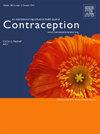ABORTION ACCESS FOR US SERVICEWOMEN POST-DOBBS V JACKSON WOMEN’S HEALTH ORGANIZATION: A QUALITATIVE STUDY
IF 2.3
2区 医学
Q1 OBSTETRICS & GYNECOLOGY
引用次数: 0
Abstract
Objectives
We aimed to explore the lived experiences of active-duty servicewomen obtaining abortion care and assess their knowledge, attitudes, and beliefs regarding policy changes made by the Department of Defense meant to facilitate access to abortion care following the Dobbs decision.
Methods
This is a qualitative study. Data were collected anonymously using online open response free-text questions. Participants could opt-in for a semi-structured interview. Thematic analysis was used to analyze data.
Results
Fifty participants (n=50) identifying as active-duty servicewomen who obtained abortion care after Dobbs completed the online open response free-text questions and four (n=4) participated in a semi-structured interview. The average age was 28.9 years; 54% (n=27) identified as White, 24% (n=12) as Hispanic; 60% (n=30) were married; 58% (n=29) were Officers; 66% (n=33) served in the Army; and 40% (n=20) were stationed in states with full or partial abortion bans. Only two participants used the DOD travel policy meant to facilitate access to care (but requiring pregnancy disclosure) and 52% (n=26) did not want to disclose their pregnancy to leadership. Medical and travel costs, unsupportive military healthcare providers and leadership, and a lack of training on abortion-related policies were identified as barriers to care. Online services providing medication abortions were identified as a facilitator to care.
Conclusions
Future policies meant to facilitate access to abortion care should ensure that servicewomen do not need to disclose their pregnancies to leadership.
美国服兵役妇女在产后堕胎的机会与杰克逊妇女健康组织:一个定性研究
目的:本研究旨在探讨现役女性获得堕胎护理的生活经历,并评估她们对国防部在多布斯判决后为促进获得堕胎护理而做出的政策变化的了解、态度和信念。方法定性研究。数据是通过在线开放回答的自由文本问题匿名收集的。参与者可以选择参加半结构化的面试。采用主题分析法对数据进行分析。结果50名(n=50)在Dobbs完成在线开放回答自由文本问题后接受堕胎护理的现役妇女,4名(n=4)参加了半结构化访谈。平均年龄28.9岁;54% (n=27)为白人,24% (n=12)为西班牙裔;60% (n=30)已婚;58% (n=29)为军官;66% (n=33)在陆军服役;40% (n=20)驻扎在完全或部分禁止堕胎的州。只有两名参与者使用了国防部的旅行政策,旨在促进获得医疗服务(但要求披露怀孕情况),52% (n=26)的人不想向领导透露自己的怀孕情况。医疗和旅行费用、不提供支持的军事保健提供者和领导以及缺乏有关堕胎政策的培训被认为是提供护理的障碍。提供药物流产的在线服务被确定为促进护理的工具。结论:未来旨在促进堕胎护理的政策应确保服役妇女不需要向领导披露其怀孕情况。
本文章由计算机程序翻译,如有差异,请以英文原文为准。
求助全文
约1分钟内获得全文
求助全文
来源期刊

Contraception
医学-妇产科学
CiteScore
4.70
自引率
17.20%
发文量
211
审稿时长
69 days
期刊介绍:
Contraception has an open access mirror journal Contraception: X, sharing the same aims and scope, editorial team, submission system and rigorous peer review.
The journal Contraception wishes to advance reproductive health through the rapid publication of the best and most interesting new scholarship regarding contraception and related fields such as abortion. The journal welcomes manuscripts from investigators working in the laboratory, clinical and social sciences, as well as public health and health professions education.
 求助内容:
求助内容: 应助结果提醒方式:
应助结果提醒方式:


